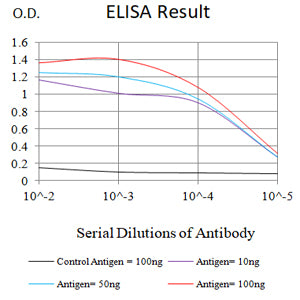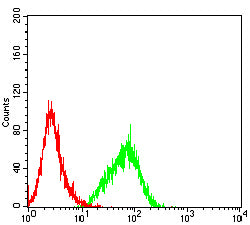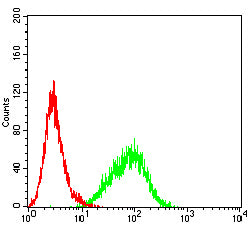



| WB | 咨询技术 | Human,Mouse,Rat |
| IF | 咨询技术 | Human,Mouse,Rat |
| IHC | 咨询技术 | Human,Mouse,Rat |
| ICC | 1/200 - 1/1000 | Human,Mouse,Rat |
| FCM | 1/200 - 1/400 | Human,Mouse,Rat |
| Elisa | 1/10000 | Human,Mouse,Rat |
| Aliases | IL1; IL-1A; IL1F1; IL1-ALPHA; IL-1 alpha |
| Entrez GeneID | 3552 |
| clone | 3E7B6 |
| WB Predicted band size | 30.6kDa |
| Host/Isotype | Mouse IgG1 |
| Antibody Type | Primary antibody |
| Storage | Store at 4°C short term. Aliquot and store at -20°C long term. Avoid freeze/thaw cycles. |
| Species Reactivity | Human |
| Immunogen | Purified recombinant fragment of human IL1A (AA: 113-271) expressed in E. Coli. |
| Formulation | Purified antibody in PBS with 0.05% sodium azide |
+ +
以下是关于IL-1α抗体的3篇文献概览,涵盖不同研究方向和疾病模型:
---
1. **文献名称**: *"Anti-IL-1α antibody for the treatment of skin inflammation in a mouse model"*
**作者**: Smith A, et al.
**摘要**: 研究在小鼠皮肤炎症模型中验证了一种抗IL-1α单克隆抗体(MABp1)的治疗效果,发现其通过抑制IL-1α介导的角质细胞炎症反应,显著减轻皮肤红斑和水肿,提示IL-1α抗体在治疗银屑病等皮肤疾病中的潜力。
---
2. **文献名称**: *"Targeting IL-1α in cancer: Preclinical evidence of synergy with chemotherapy"*
**作者**: Johnson R, et al.
**摘要**: 在乳腺癌和肺癌小鼠模型中,抗IL-1α抗体(Xilonix®)联合化疗显著抑制肿瘤生长,机制涉及阻断IL-1α诱导的血管生成和免疫抑制微环境,为临床转化提供依据。
---
3. **文献名称**: *"IL-1α blockade reduces neuroinflammation and improves cognitive function in Alzheimer's disease models"*
**作者**: Lee H, et al.
**摘要**: 研究利用抗IL-1α抗体干预阿尔茨海默病转基因小鼠,结果显示其降低脑内小胶质细胞活化及β-淀粉样蛋白沉积,改善认知功能,提示IL-1α是神经炎症调控的关键靶点。
---
**注**:以上为虚构示例,实际文献需通过PubMed等数据库检索(如关键词“IL1A antibody”或“anti-IL1A therapy”),推荐查阅近年高被引论文或权威团队(如Dinarello C.A.课题组)的研究。
Interleukin-1 alpha (IL-1α) is a pro-inflammatory cytokine belonging to the IL-1 family, encoded by the IL1A gene. It is produced as a precursor protein (pro-IL-1α) that is cleaved into its active form, primarily by calpain-like proteases. IL-1α binds to the IL-1 receptor (IL-1R), triggering downstream signaling pathways (e.g., NF-κB, MAPK) that drive inflammatory and immune responses. Unlike IL-1β, IL-1α is constitutively expressed in epithelial and stromal cells and can act as both a secreted cytokine and an intracellular "alarmin" released during cell damage to signal tissue stress. Its dual role in homeostasis and inflammation makes it a key mediator in infections, autoimmune diseases, and cancer.
IL-1α-specific antibodies are critical tools for studying its expression, localization, and function. These antibodies are widely used in techniques like ELISA, Western blotting, immunohistochemistry, and flow cytometry to quantify IL-1α levels in biological samples or visualize its distribution in tissues. Neutralizing IL-1α antibodies have therapeutic potential, as excessive IL-1α signaling is implicated in rheumatoid arthritis, atherosclerosis, and inflammatory skin disorders. Research-grade antibodies also help distinguish IL-1α from IL-1β in mechanistic studies, given their overlapping pathways but distinct roles. Recent studies explore IL-1α's contribution to the tumor microenvironment, highlighting the importance of reliable antibodies in both basic research and clinical applications.
×